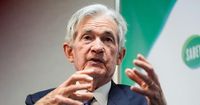The Federal Reserve is widely expected to maintain its benchmark interest rate within the range of 4.25% to 4.5% during its meeting on May 7, 2025. This decision marks the third consecutive time the central bank has opted to keep rates steady as it navigates the complex economic landscape shaped by President Donald Trump’s tariffs and ongoing inflationary pressures.
Fed Chair Jerome Powell has indicated a cautious approach, emphasizing the need to monitor labor market conditions and inflation before making any cuts to interest rates. Despite pressures from the White House to lower borrowing costs, uncertainty surrounding the impact of tariffs on the economy has led many economists to predict the Fed will adopt a "wait and see" stance for the time being.
Economists are increasingly concerned that the tariffs imposed by the Trump administration could exacerbate inflationary pressures. As households curb spending amid fears of a recession, investors are also pulling back, contributing to a volatile stock market. The Fed's decisions on interest rates are pivotal, influencing everything from auto loans and mortgages to credit card interest rates, which currently hover above 21%.
According to Matthew Martin, a senior US economist with Oxford Economics, "The Fed's monetary policy will depend on which side of their mandate, inflation or employment, is farthest from target." This balancing act, often referred to as a "soft landing," requires the Fed to find an equilibrium where the economy is neither too hot nor too cold.
Despite the Fed's cautious approach, there are signs of economic strain. The U.S. economy contracted at an annual rate of 0.3% in the first quarter of 2025, a decline attributed to a surge in goods imports as businesses rushed to stock up before tariffs took effect. However, consumer spending remained relatively strong, increasing by 1.8%, and business investments soared by 22.5% during the same period.
With unemployment at a historically low 4.2%, the labor market has shown resilience, adding 177,000 jobs in April 2025 alone. Yet, the specter of rising inflation looms large, with the Fed's preferred inflation measure dipping slightly from 2.5% to 2.3% in March. Still, experts predict that inflation could rise significantly in the coming months, potentially peaking at 3.8% in 2025.
Trump's tariffs have created a complicated scenario for the Fed. Gisela Young, a U.S. economist at Citigroup, explains, "Tariffs create a complicated situation for the Fed because they imply upside risk for inflation—but downside risk for growth and the labor market." This dual risk complicates the Fed's decision-making process, as any increase in inflation could lead to higher interest rates, while a downturn in the economy might necessitate cuts.
As the Fed prepares for its upcoming meeting, many investors believe it will keep rates steady through June, with the first potential cut coming in July 2025. However, opinions vary among economists, with some advocating for immediate cuts to stimulate growth while others caution against premature action.
Ed Yardeni, head of Yardeni Research, remarked, "The best thing for them to do is wait to see: Do they have more of a problem with inflation or rising unemployment?" This sentiment reflects a broader consensus among Fed officials, who are wary of acting too quickly without clear signs of economic deterioration.
In the face of these uncertainties, the Fed's messaging remains crucial. Powell is expected to reiterate that the central bank will take a balanced approach, prioritizing whichever goal—stable prices or maximum employment—appears to be further from target. As the economic landscape evolves, the Fed will continue to assess the impact of tariffs and other factors on inflation and employment.
As consumers and businesses brace for potential changes, the implications of the Fed's decisions are far-reaching. For individuals seeking loans or mortgages, the cost of borrowing remains high, with credit card rates still elevated. However, savings rates may remain attractive as they are closely tied to the federal funds rate.
In conclusion, the Federal Reserve's decision to hold interest rates steady reflects a cautious approach amid a complex economic landscape shaped by tariffs and inflation. As the central bank navigates these challenges, its decisions will have significant implications for consumers, businesses, and the broader economy.





